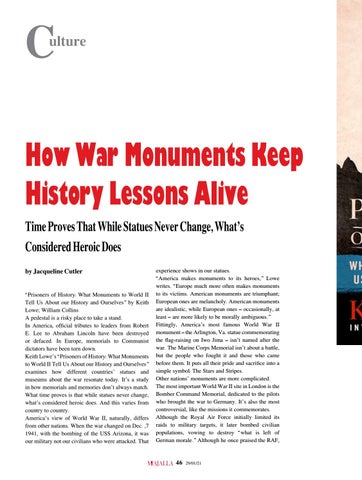C
ulture
How War Monuments Keep History Lessons Alive Time Proves That While Statues Never Change, What’s Considered Heroic Does by Jacqueline Cutler “Prisoners of History: What Monuments to World II Tell Us About our History and Ourselves” by Keith Lowe; William Collins A pedestal is a risky place to take a stand. In America, official tributes to leaders from Robert E. Lee to Abraham Lincoln have been destroyed or defaced. In Europe, memorials to Communist dictators have been torn down. Keith Lowe’s “Prisoners of History: What Monuments to World II Tell Us About our History and Ourselves” examines how different countries’ statues and museums about the war resonate today. It’s a study in how memorials and memories don’t always match. What time proves is that while statues never change, what’s considered heroic does. And this varies from country to country. America’s view of World War II, naturally, differs from other nations. When the war changed on Dec. ,7 1941, with the bombing of the USS Arizona, it was our military not our civilians who were attacked. That
experience shows in our statues. “America makes monuments to its heroes,” Lowe writes. “Europe much more often makes monuments to its victims. American monuments are triumphant; European ones are melancholy. American monuments are idealistic, while European ones – occasionally, at least – are more likely to be morally ambiguous.” Fittingly, America’s most famous World War II monument – the Arlington, Va. statue commemorating the flag-raising on Iwo Jima – isn’t named after the war. The Marine Corps Memorial isn’t about a battle, but the people who fought it and those who came before them. It puts all their pride and sacrifice into a simple symbol: The Stars and Stripes. Other nations’ monuments are more complicated. The most important World War II site in London is the Bomber Command Memorial, dedicated to the pilots who brought the war to Germany. It’s also the most controversial, like the missions it commemorates. Although the Royal Air Force initially limited its raids to military targets, it later bombed civilian populations, vowing to destroy “what is left of German morale.” Although he once praised the RAF,
46
29/01/21
